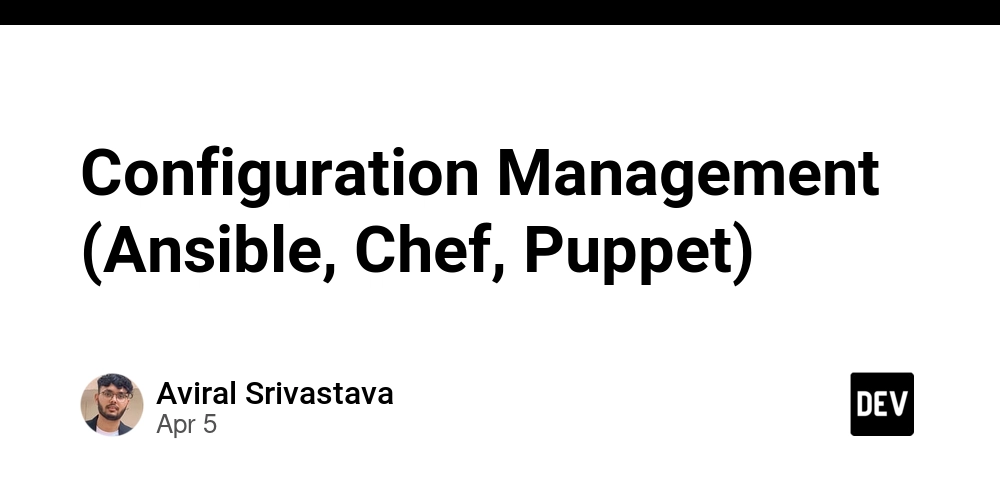Configuration Management (Ansible, Chef, Puppet)
Configuration Management: Automating Infrastructure Introduction: Configuration Management (CM) tools automate the provisioning and management of IT infrastructure. Leading tools include Ansible, Chef, and Puppet, each offering different approaches to achieving consistent and repeatable system configurations. These tools are vital for DevOps practices, enabling faster deployments and improved scalability. Prerequisites: Implementing CM requires a basic understanding of networking, operating systems (Linux and/or Windows), and scripting. Familiarity with SSH and command-line interfaces is beneficial. For Ansible, Python is a prerequisite. Chef and Puppet generally require agent installation on managed nodes. Features: All three tools offer features like: Idempotency: Applying a configuration multiple times yields the same result, preventing unintended changes. Version Control: Configurations are stored in version control systems (e.g., Git), enabling rollback and collaboration. Automation: Reduces manual tasks and human error through automated deployments and updates. Modularization: Configurations are broken down into manageable modules, promoting reusability. Advantages: Increased Efficiency: Automates repetitive tasks, freeing up administrators. Improved Consistency: Ensures all systems are configured identically. Reduced Errors: Minimizes human error in configuration. Faster Deployments: Streamlines the deployment process. Disadvantages: Learning Curve: Mastering any of these tools takes time and effort. Complexity: Managing complex infrastructures can become challenging. Agent Dependency (Chef, Puppet): Requires installing agents on managed nodes, potentially adding overhead. Vendor Lock-in: Switching between tools can be difficult. Ansible Example (Simplified): - hosts: webservers become: true tasks: - name: Install Apache apt: name: apache2 state: present Conclusion: Configuration management tools are essential for modern IT operations. While each tool has its strengths and weaknesses, Ansible, Chef, and Puppet all significantly improve infrastructure management efficiency, consistency, and reliability. Choosing the right tool depends on specific needs and team expertise.

Configuration Management: Automating Infrastructure
Introduction:
Configuration Management (CM) tools automate the provisioning and management of IT infrastructure. Leading tools include Ansible, Chef, and Puppet, each offering different approaches to achieving consistent and repeatable system configurations. These tools are vital for DevOps practices, enabling faster deployments and improved scalability.
Prerequisites:
Implementing CM requires a basic understanding of networking, operating systems (Linux and/or Windows), and scripting. Familiarity with SSH and command-line interfaces is beneficial. For Ansible, Python is a prerequisite. Chef and Puppet generally require agent installation on managed nodes.
Features:
All three tools offer features like:
- Idempotency: Applying a configuration multiple times yields the same result, preventing unintended changes.
- Version Control: Configurations are stored in version control systems (e.g., Git), enabling rollback and collaboration.
- Automation: Reduces manual tasks and human error through automated deployments and updates.
- Modularization: Configurations are broken down into manageable modules, promoting reusability.
Advantages:
- Increased Efficiency: Automates repetitive tasks, freeing up administrators.
- Improved Consistency: Ensures all systems are configured identically.
- Reduced Errors: Minimizes human error in configuration.
- Faster Deployments: Streamlines the deployment process.
Disadvantages:
- Learning Curve: Mastering any of these tools takes time and effort.
- Complexity: Managing complex infrastructures can become challenging.
- Agent Dependency (Chef, Puppet): Requires installing agents on managed nodes, potentially adding overhead.
- Vendor Lock-in: Switching between tools can be difficult.
Ansible Example (Simplified):
- hosts: webservers
become: true
tasks:
- name: Install Apache
apt:
name: apache2
state: present
Conclusion:
Configuration management tools are essential for modern IT operations. While each tool has its strengths and weaknesses, Ansible, Chef, and Puppet all significantly improve infrastructure management efficiency, consistency, and reliability. Choosing the right tool depends on specific needs and team expertise.









































































































































































![[The AI Show Episode 142]: ChatGPT’s New Image Generator, Studio Ghibli Craze and Backlash, Gemini 2.5, OpenAI Academy, 4o Updates, Vibe Marketing & xAI Acquires X](https://www.marketingaiinstitute.com/hubfs/ep%20142%20cover.png)


























































































































![[FREE EBOOKS] The Kubernetes Bible, The Ultimate Linux Shell Scripting Guide & Four More Best Selling Titles](https://www.javacodegeeks.com/wp-content/uploads/2012/12/jcg-logo.jpg)



![From drop-out to software architect with Jason Lengstorf [Podcast #167]](https://cdn.hashnode.com/res/hashnode/image/upload/v1743796461357/f3d19cd7-e6f5-4d7c-8bfc-eb974bc8da68.png?#)







































































































.png?#)




.jpg?#)




















 (1).webp?#)











_Christophe_Coat_Alamy.jpg?#)








































































































![Rapidus in Talks With Apple as It Accelerates Toward 2nm Chip Production [Report]](https://www.iclarified.com/images/news/96937/96937/96937-640.jpg)








































































































































